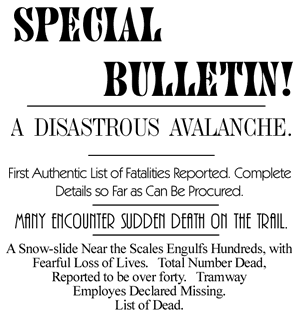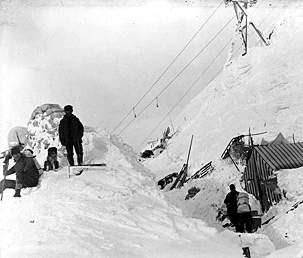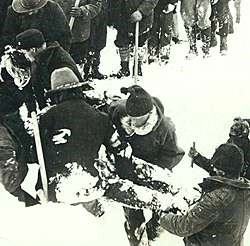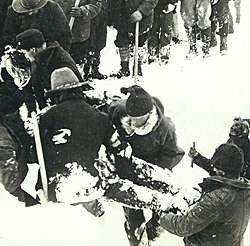Last updated: October 26, 2021
Article
The Palm Sunday Avalanche

The deadliest event of the Klondike Gold Rush occurred on April 3, 1898, between Sheep Camp and the Scales on the Chilkoot Trail. Numerous snow slides took place on that day. Five slides directly involved stampeders, and three resulted in the loss of life. Another slide the following day took the lives of two others.¹ Altogether over 65 lives were probably lost. Many other snow slides took place on the Chilkoot Trail during the gold rush, but relatively few endangered the lives of stampeders.²
The Palm Sunday avalanche was one of the most widely reported events of the gold rush. Coverage of the disaster was probably second only to the initial news proclaiming the wealth of the gold fields. Scores of stampeders, moreover, wrote about the event, whether they were close to the scene or not. The story of the snow slide, therefore, is one which details the spread of information and rumor as much as it chronicles the event. The following compilation, taken from some of the available literature, attempts to detail those aspects of the snow slide that most directly affect present-day resources.
Dangerous Conditions
The conditions that caused these avalanches were typical of those creating avalanches anywhere. The upper reaches of the Chilkoot Trail experience many avalanches each year, and spring is a common time for them.³ Heavy snow had fallen on the higher slopes during February and March 1898, but on the first two days of April, warm winds from the south created unstable conditions. It then began to snow again. Veterans of the trail, both white and Alaska Native, were aware of the danger of avalanches. Alaska Natives refused to pack above Sheep Camp, and white packers warned others against entering the slide-prone area. A few stampeders, however, ignored their warnings and made plans to carry their goods up the trail.

Photo courtesy of University of Washington's Eric A. Hegg Collection
Avalanche!
On the night of April 2, avalanches began to tumble down the slopes above the Scales. At about 2:00 the next morning, one of the slides buried twenty stampeders in the Scales area; another one, at about 9:30, buried three others.5 All of these people were rescued, but the roar of additional snow slides convinced the entire Scales population to evacuate, along with a number of construction workers for the Chilkoot Railroad and Transport Company who had been on the top of Chilkoot Pass. Some 220 people, therefore, began to descend toward Sheep Camp.6 Workmen for the tramway went first; the remainder left the Scales between 10:45 and 11:00 a.m.7 At the time of the mass descent, it was snowing heavily, and visibility was cut almost to zero.
Between 10:00 a.m. and noon, three fatal snow slides cascaded down from the eastern escarpment.9 The first slide took place at Squaw Hill, which was north of Stone House but south of the Alaska Railroad and Transportation Company powerhouse. Here three campers were crushed to death in their tents. Here also an ox named Marc Hanna was enveloped in snow. Despite his burial several feet under the top of the slide the ox was unhurt, and after being extricated was put to work hauling the bodies of slide victims down to Dyea.
Sometime later, the party of CR&T Company construction workers came down the trail from the Scales. As they were passing through a narrow gorge near the AR&T powerhouse, a second avalanche buried the entire party. All were killed. This avalanche probably occurred on a cut-off trail (an alternate to the regular Chilkoot Trail) that followed along the east side of "drow-a-low" ravine, located east and about 800 feet north of the AR&T powerhouse.
There is some confusion regarding how the construction men got to this area. One source, based on supposedly eyewitness accounts, claims that the group headed north from Sheep Camp at 8 a.m. and were engulfed by the slide as they headed north. More reliable sources stated that the crew headed down from the summit in the mid-morning, and were killed as they hiked south. Either way they went, the low visibility may have caused them to wander off the main path.

Photo courtesy of University of Washington's Eric A. Hegg Collection.
The largest and most destructive slide came soon afterwards. The main party from the Scales followed in the recently-created footsteps of the construction crew. The entire group of 200-odd stampeders, together with several dogs, marched in a long, sinuous line. Due to the low visibility, they were kept together by a 200-foot-long rope given to them by the construction crew. This rope had previously been used to haul freight from the Scales up to the summit of Chilkoot Pass. The group descending toward Sheep Camp lined up on alternate sides of the rope. Shovels were the group's only known luggage.12
Following the path of the construction crew, the party left the main trail about 1000 feet below the Scales, angled left, and entered "drow-a-low" ravine sometime between 11:00 a.m. and noon.13 They were totally unaware of the fate of the construction crew, and could barely make out their tracks in the swirling snowstorm. About a third of the party had entered the upper end of the ravine when the mountainside again gave way.
Those in the rear of the party were untouched, but those holding the front end of the rope were buried, some to a depth of between twenty and fifty feet. The entire slide area was about ten acres in extent; about 150 yards of the cut-off trail was affected.14 The avalanche was accompanied by a "fearful rush" of wind from the east; doubtless the wind, the recent heavy snow, the warming trend and the impact of the many closely-spaced people traversing the fragile snow pack triggered both this snow slide and the one which had descended upon the construction crew. Unlike some avalanches, this one carried no trees, stones or ice. In addition to the people it swept away, it engulfed many provisions which had been cached along its path.15

Photo courtesy of University of Washington's Eric A. Hegg Collection
Rescue and Recovery
Rescue operations continued for the next four days, and traffic over the trail halted. Rescuers first attempted to save as many lives as possible. Estimates varied widely as to the number of lives that were saved. Edwin M. Wold noted that "only one or two persons were taken out alive." The New York Times, however, noted that 25 had been rescued, and the Dyea Press claimed that 40 or 50 were pulled from the snow pack because they held onto the communal rope. Even more extreme was William Hunt's assertion that "frantic rescuers pulled over 100 men to safety." A compilation of accounts appears to indicate that at least ten people who were initially buried by the snow pack were dug out alive. At least four of those, however, later died of exposure.18
The number that died in the snow slide is even more open to conjecture than the number who were saved. At first, wild reports were circulated that two or three hundred lives were lost.19 But after the rescue process began, more modest estimates were made, and several lists of the dead were compiled. Four different lists, each appearing in different publications, were known to be produced. The number of names on the four lists was 48, 51, 65 and 70. Significantly, few names appear on all four lists. The sources for these lists are not known, and because almost no biographical information is known about the large majority of the victims, there is no practical way to verify the authenticity of the various lists. A fifth list of names appears on the headboards at Dyea's Slide Cemetery. Because many remains were shipped Outside for burial, this list is not complete. It is significant, however, that several of the names on those headboards do not match those found on any of the published lists.20
See the park's list of victims

Casuality Confusion
The reason that the number and identity of the victims is so inconsistent lies in the transient nature of the stampeders, the inefficiency in the identification and burial process, and the physical difficulty in accounting for all the victims. In a rare display of unanimity and selflessness, the stampeders abandoned their collective trek in order to rescue and locate the snow slide victims. A tent in Sheep Camp was donated for use as a morgue, and the local Citizens' Committee, appointed at a miners' meeting, officially presided over the processing of the bodies for shipment and burial.21 Eyewitness accounts indicate that most or all of the victims were identified and claimed, and death certificates were issued. The Dyea Trail assured its readers that "a complete record of all transactions [was] kept. A list of the principal effects found on a number of the bodies, and a record of the Committee's work will be filed with the United States Commissioner's office at Dyea."22
Reports indicate, however, that the identification and burial process was flawed. One story noted that con-man "Soapy" Smith had himself appointed coroner, and before Mounted Police officers could intervene, many of Smith's gang members had stripped the bodies of cash, jewelry and other valuables.23 Moreover, no existing records from the Commissioner's office show either the death certificates or the lists of the victims' personal effects. It is unlikely, based upon these discrepancies, that the number or identity of those killed will ever be known.
Today
The Slide Cemetery near Dyea is the major existing landmark for the Palm Sunday snow slide. The site of the slide itself is marked only by a nearby interpretive sign. The marker is located along the recreational trail and is thus away from the site of the slide, and is south instead of north of the powerhouse remains. The ravine where the slide took place has not been specifically located or marked.Endnotes
1. Dyea Press, 5/21/98, p. 2.2. The following accounts recorded gold rush slide activity: Condon, "Letters," p. 9; Victoria Colonist, 12/22/98, p. 2; Satterfield, Chilkoot Pass, 1978, p. 136; Lyons, "An American Girl's Trip," p. 21; Mizony, "Gold Rush," p. 7; Moore, Skagway, p. 45; Heller, Sourdough Sagas, p. 79; Price, From Euston to Klondike, p. 84; White, "Diary," p. 3; Beatty, "Diary," 5/2/98.
3. Jay Cable, Interview by Frank Norris, 3/5/86.
4. Dyea Trail, 4/9/98.
5. New York Times, 4/10/98, 6/13/98; Lung/Martinsen, Black Sand and Gold, p. 376.
6. The campers who evacuated the Scales later found out that slides had buried many tents after they left. New York Times, 6/13/98.
7. The number of tramway workmen has been variously estimated as 17, 19 and 23; published lists of the dead inexplicably indicate that only five were involved. New York Times, 4/10/98; Lokke, Klondike Saga, p. 63; Graham, "Diary," pp. 5-6; Steele, Forty Years in Canada, p. 307; Dyea Press, 4/6/98.
8. Lokke, Klondike Saga, p. 63; Bearss, Klondike Gold Rush, pp. 116-17.
9. Several sources have erroneously suggested that the main snow slide took place on the Peterson route, or on the main trail above the Scales. Alaska DNR, "The Chilkoot Trail," 1968, p. 15; William R. Hunt, North of 53 (New York, Macmillan, l974), pp. 48-49; William Bronson with Richard Reinhardt, The Last Grand Adventure (New York, McGraw Hill, l977), p. 96; Cohen, The Streets Were Paved With Gold, p. 65.
10. Newspaper reports called this the O&I powerhouse (an abbreviation of the Oregon Improvement Company). Both the Oregon Improvement Company and the Alaska Railroad and Transportation Company were subsidiaries of the Pacific Coast Steamship Company transportation network. New York Times, 4/10/98; Dyea Trail, 4/9/98; Bearss, Klondike Gold Rush, p. 117.
11. Lokke, Klondike Saga, p. 63; Bearss, Klondike Gold Rush, pp. 116-18.
12. New York Times, 6/13/98; Mizony, "Gold Rush," p. 7; Lung/Martinsen, Black Sand and Gold, p. 379.
13. Dyea Press, 4/6/98.
14. Lung/Martinsen, Black Sand and Gold, p. 377; Dyea Press, 4/6/98.
15. Lokke, Klondike Saga, p. 63; Bearss, Klondike Gold Rush, p. 118; Nerland in NAHA, Norwegian-American Studies, p. 136.
17. Several sources have implied that the Sheep Camp rescuers were on the scene within fifteen minutes. Inasmuch as two and one-half miles separated Sheep Camp from the slide site, this is unlikely. It is true that some rescue work, by the survivors from the Scales party, began immediately after the slide. But the lives of those involved in the slide were not contingent upon the speed by which the rescuers arrived. Some victims, such as the tramway workers, may have been killed immediately, while others evidently suffocated several hours later. This conclusion is disputed by a report which claimed that those buried most deeply in the largest slide were killed instantly by the great weight of snow which cascaded down upon them. Hypothermia did not appear to be a major cause of death. Dyea Trail, 4/9/98; Lung/Martinsen, Black Sand and Gold, p. 378; Bearss, Klondike Gold Rush, p. 119; Dyea Press, 4/6/98.
18. Lokke, Klondike Saga, p. 62; New York Times, 4/10/98; Dyea Press, 4/6/98; Hunt, North of 53, p. 49.
19. Tuck, "Klondike Diary," p. 7; John J. Hjelsing, "My Trip to the Gold Fields of the Klondike," unpub. mss., p. 8; Lung/Martinsen, Black Sand and Gold, p. 378.
20. Spude, Chilkoot Trail, pp. 181-87; Dave Clabaugh, unpub. mss., 1979, in KLGO "Tragedies" file.
21. Bearss, Klondike Gold Rush, pl. 73; Dyea Trail, 4/9/98.
22. Nerland in NAHA, Norwegian-American Studies, p. 136; Dyea Trail, 4/9/98, 4/11/98.
23. Berton, Klondike, p. 266; Davis, Sourdough Gold, pp. 52-53.
